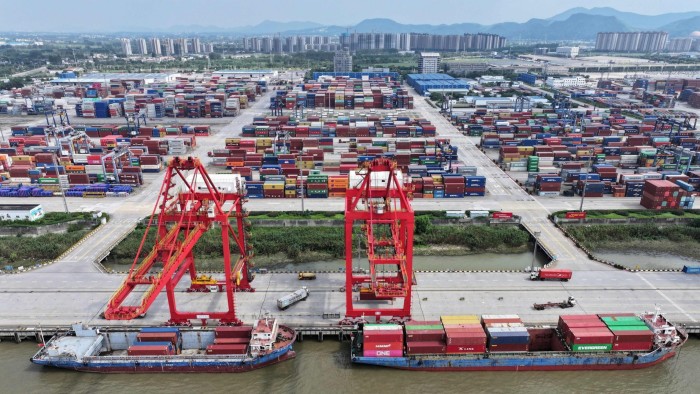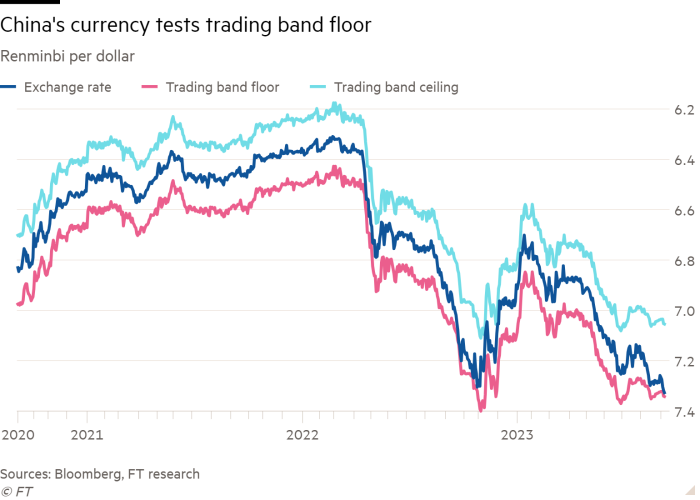China’s renminbi hits 16-year low after exports tumble in August

Simply sign up to the Chinese trade myFT Digest -- delivered directly to your inbox.
China’s currency has fallen to its lowest point against the dollar since 2007 after exports shrank for a fourth straight month in August, showing how the manufacturing sector in the world’s second-largest economy is struggling to regain momentum.
The renminbi edged down 0.1 per cent to a low of Rmb7.3259 per dollar on Thursday, lower than the levels recorded during nationwide pandemic lockdowns last year, after an official release showed China’s exports dropped 8.8 per cent in August compared with a year ago.
The August exports contraction was less severe than a forecast fall of 9.2 per cent, according to analysts polled by Reuters, and was better than July’s 14.5 per cent decline, the worst since the start of the coronavirus pandemic.
Chinese trade buoyed economic activity during lockdowns, but exporters have struggled this year as foreign customers cut back purchases on high global inflation.
The Chinese currency, meanwhile, has fallen almost 6 per cent against the dollar this year as disappointing economic data and a strengthening US dollar piled pressure on the exchange rate, despite a number of direct and indirect measures by Chinese authorities to discourage bets against the currency.
“Crossing this level raises the possibility of the [People’s Bank of China] adjusting the currency band to a weaker level,” said Ken Cheung, chief Asia foreign exchange strategist at Mizuho Bank. China’s central bank sets a daily trading band midpoint around which the renminbi can fluctuate 2 per cent in either direction against the dollar.
“Tomorrow’s midpoint fix will be quite an important indicator of whether the PBoC is willing to change its approach to currency management and unleash that depreciation power,” Cheung said.

The sustained weakness in trade and manufacturing — two of the economy’s main growth engines — comes as Chinese policymakers face concerns that the post-pandemic recovery has failed to take off.
But Beijing has refrained from enacting sweeping stimulus measures to revive growth, which expanded just 0.8 per cent in the second quarter on the previous three months. Sluggish consumer sentiment led to price deflation in July, while factory activity slowed for a fifth straight month in August.
China last week unveiled its strongest recent measures to prop up a moribund property market, but analysts argued more would be needed to reach the government’s full-year growth goal of 5 per cent, already the lowest target in decades.
The country’s customs authority said imports dropped 7.3 per cent in August, compared with a Reuters forecast of a 9 per cent decline and a 12.4 per cent fall in July. The August trade surplus was $68.36bn, down 13.2 per cent year on year.
Car exports soared 104.4 per cent during the January-August period, reflecting China’s huge output of electric vehicles, while crude oil shipments by volume were up 14.7 per cent year on year and soyabean import volumes jumped 17.9 per cent, the customs authority said.
The Association of Southeast Asian Nations — a bloc that includes Indonesia, Thailand, Singapore, Malaysia and Vietnam — was China’s biggest trading partner in renminbi terms during the first eight months of the year. Total trade with the EU, US and Japan, its next largest trading partners, fell.
Economists said the better than expected trade data showed the process of manufacturers “destocking” excess inventories built up during the pandemic was gradually ending.
“It’s not just China, but if you look at the other Asian countries, their August trade numbers are also better,” said Robin Xing, chief China economist at Morgan Stanley.
Analysts at Oxford Economics said there were signs the sharp downturn in semiconductors, a critical component of trade in Asia, was bottoming out. Global car exports also regained pre-pandemic levels.
But they cautioned that other indicators showed “a shallow trade recession” for the world this year, followed by a modest recovery.
“Further spillovers to world trade from depressed trade in China could be substantial, slowing industrial expansion in the region and hitting commodity prices,” they wrote.
Comments